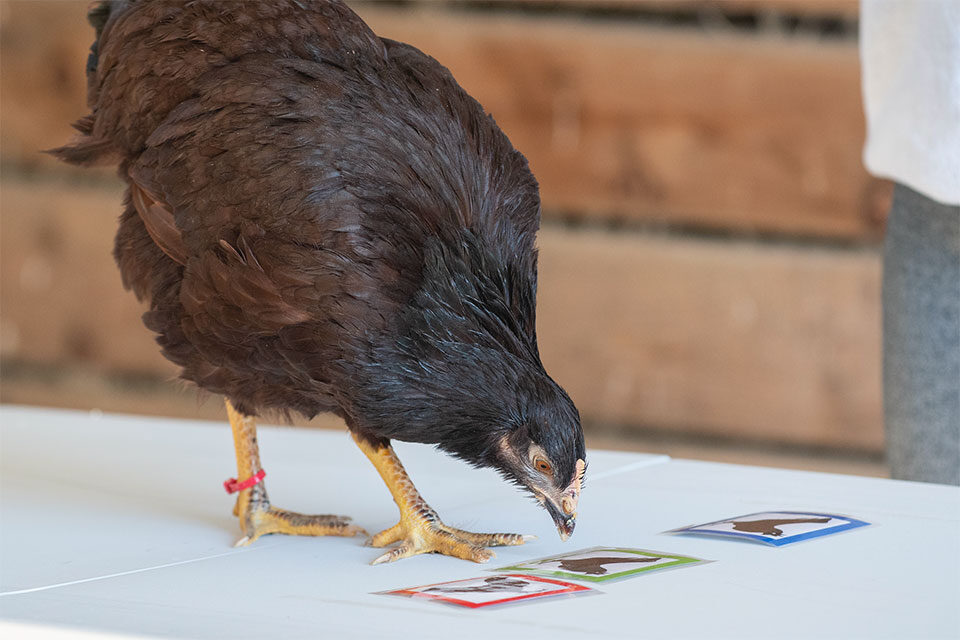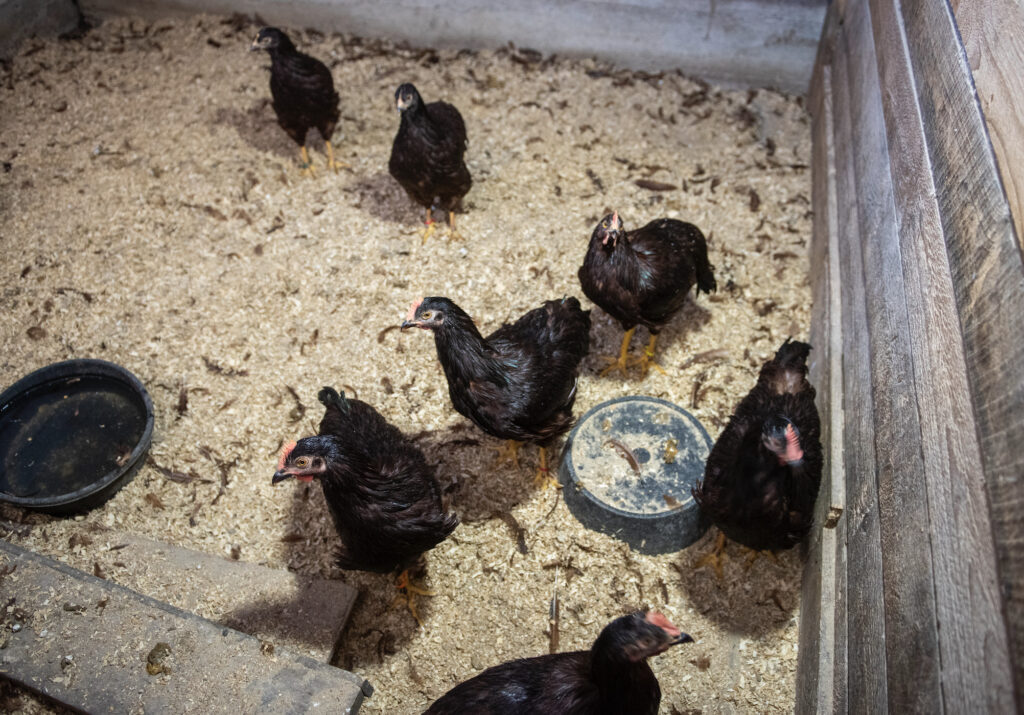Behavior analysis graduate students learn to train chickens

It didn’t take long for graduate student Ryan Hartley to have Red, a 4-month-old Rhode Island Red chicken, eating out of his hand at Casey Farm in Saunderstown. More notably, it didn’t take Red very long to shape her behavior precisely the way Hartley wanted in order to earn a few more pecks at the cornmeal and sunflower seed reward dish.
Hartley recently joined his fellow students in the behavior analysis graduate program at the historic farm to participate in a chicken training workshop embedded into the course PSY520: Concepts and Principles, developed by Dr. Cody Morris, assistant professor and graduate program director in the Department of Psychology. Using a reinforcing “clicker” followed by the reward food, students taught the chickens to select specific icons out of an increasingly complex array by pecking it.
The workshop demonstrated two important behavior analytic concepts – shaping and discrimination – critical to the work they will employ after graduation when helping individuals with developmental disabilities learn the skills they need to live as independently and autonomously as possible.
“Behavior analysis is a field that applies to all living organisms and we can truly teach new behaviors through its various concepts and principles,” said Hartley, a treatment coordinator at Autism Care Partners in Warwick, Rhode Island. Hartley will pursue Board Certified Behavior Analyst (BCBA) certification and is considering a career in law enforcement.
“The chicken training gave us the opportunity to see the concepts we’ve been learning in class, in practice,” said Rebecca Ward ’21, who is enrolled in Salve Regina’s combined bachelor’s/master’s program. Ward works with children with autism and other developmental disorders as a behavior technician at Pathways Strategic Teaching Center in Coventry, Rhode Island.
“It’s one thing to learn about shaping behavior in class and a whole different thing to implement it,” Ward said. “In the future, I hope to be a BCBA and work with children with autism and other developmental disabilities in a school or clinic setting. This program and practical experience puts me in the best position to achieve that.”
Hatching the workshops
Morris said medical professions often require students to learn about simple animal anatomy before graduating to human anatomy because it is easier to demonstrate certain concepts and structures with more basic organisms before extrapolating that information with advanced organisms.
Similarly, many behavior analysts find it helpful to expose their students to basic concepts and principles of behavior using basic organisms before applying that information to humans. Most behavior analysis programs that provide opportunities to work with animals do so through lab work with rats or pigeons. But Morris said maintaining animal labs requires a great deal of unsustainable resources.
“When I decided to embed an animal training experience into Salve’s program, I was eager to use more sustainable options,” he said. “Chickens are a great alternative to rat and pigeon training because, like rats and pigeons, they attend to stimuli well and are food motivated. But unlike rats and pigeons, they are accessible without having to disrupt their natural environment much.”
To prepare for the workshops, Morris pre-trained eight chickens at the farm by working with them 2-3 times a week for about two months to ensure they had the requisite skills to respond well to the training. Most of the pre-workshop training consisted of systematically exposing and desensitizing the chickens to stimuli they might be fearful of initially – like being handled, exposed to new people and to new sounds.
“I paired the sound of a clicker with the delivery of food to establish the sound of the click as a reinforcer, which is what we used to encourage the chickens to engage in the behaviors we were targeting,” Morris said.
He also got the chickens comfortable walking around on the plastic tables used in the training, and he brought in bystanders to stand around while preparing sessions so the chickens became used to strange spectators.
“All organisms are born with certain predispositions that make them unique and affect the way they interact with the world,” Morris said. “Each chicken that we worked with during the workshop had certain predispositions and patterns of behavior that were apparent in the pre-training and training sessions.”
For example, some of the chickens were less fearful of new stimuli, more explorative and more focused. Those chickens responded faster and better to the training because they were quicker to interact with the environment and contact the reinforcement that his students were providing. On the other hand, some of the other chickens were more timid, conservative or prone to distractions. Those chickens still respond to shaping and discrimination training, but they needed more learning opportunities and supplemental interventions.
In the same way that students had to identify and accommodate the differences among chickens during the workshop, as behavior analysis professionals working in the field, they will have to recognize each client’s individual skills and needs so that they can personalize treatment to maximize effectiveness.
“Humans are not unlike other organisms in that we all have certain predispositions,” Morris said. “Sometimes, individuals with developmental disabilities might engage in maladaptive behaviors that are harmful to themselves or others, such as attacking their caregivers. My students will frequently work with individuals that engage in such behaviors and will need to identify the specific cause of the maladaptive behaviors and help the client learn to replace them with more adaptive behaviors – such as communicating about their needs.”



